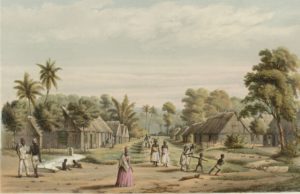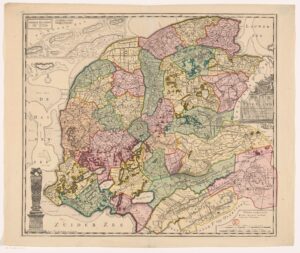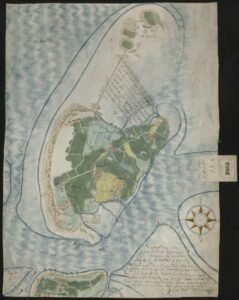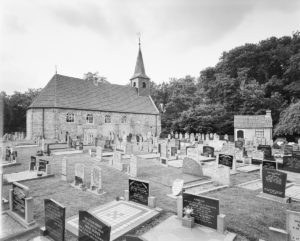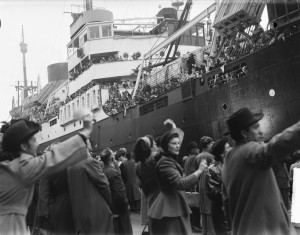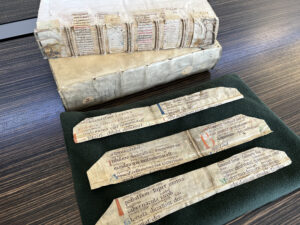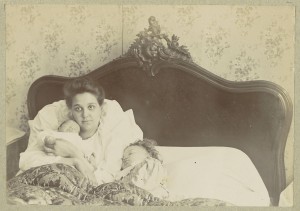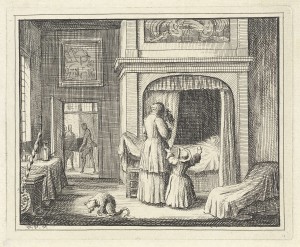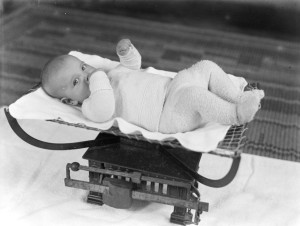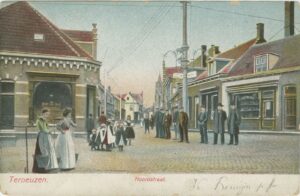Here are the new sources, websites, projects and other news announced in the past month. Sources Many of the court records of Zeeuws-Vlaanderen 1447-1796 have been scanned and can be consulted via the finding aid. Many Zeeland church records 1527-1810 have been scanned and can be consulted via the finding aid. The recess books (general series) of the court of Wijmbritseradeel (1591-1594, 1604-1608) have been added to Alle Friezen. Abstracts of court and notarial records of … [Read more...]
About this website
Creating a website like this is a fun activity. There are so many options, so many choices. What do visitors want? What do I want? In this blog I will describe some of the things I encounter in developing and maintaining this website.
Map of the Week: Friesland in 1718
This week, we are looking at a map of Friesland from 1718. In 1682, Bernardus Schotanus à Sterringa was hired to create maps of all the municipalities in Friesland. A second improved version of this series was compiled by François Halma. He added an overview map that showed all the municipalities, shown below. You can consult the maps of individual municipalities on the website Friesland op de Kaart. … [Read more...]
Map of the Week: Texel, circa 1645
In this new series we will look at a different map every week. We kick off the series with a beautiful manuscript map of the island of Texel from 1645. Many ships departing to New Netherland or other Dutch colonies would lie on the roads of Texel to take in fresh water and wait for favorable winds before crossing the ocean. … [Read more...]
How to Find Out Where Your Dutch Ancestors Were Buried
So you know where your ancestor lived in the Netherlands, and you know where and when they died. How do you find out where they are buried, and if the grave still exists? Graves are routinely cleared in the Netherlands after a few decades, so even knowing where a person was buried is no guarantee that the grave is still there. Burials in churches Until 1828, it was legal to bury people in churches. This was more expensive, so usually only richer people were buried inside the church while … [Read more...]
Quick tip – Were They the Only Immigrants in the family?
If you are researching an immigrant, they may not have been the only one in the family to immigrate. People often travelled in groups, consisting of friends and family members. Once an immigrant was established, they often encouraged others to follow. If you research their family back home, you may discover several others who also emigrated. Sometimes passenger lists will mention that they were joining a relative. … [Read more...]
Dutch Genealogy News for February 2024
Here is an overview of the new sources, websites, and other news from the Netherlands last month. Sources The notarial records of Hilvarenbeek, Geertruidenberg, Baarle-Nassau, Oisterwijk, and Raamsdonk from the 1700s have been automatically transcribed. The results can be searched on the Transkribus website. Various Utrecht tax records can now be searched at the Rijnstreek en Lopikerwaard archives. Court records of Berghem, Kessel, Lith, Oss, and Ravestein in North Brabant can now … [Read more...]
Quick tip – (Not) Naming Children After Parents
Traditionally, many Dutch children were named after family members: grandparents, deceased siblings, deceased spouses of their parents, or aunts and uncles. Though some children were named after their parents, this is rather rare. One instance where it is common for a child to be named after their parent is when the parent had died. For example, if a father died when the mother was pregnant, a son would often be given the father's name, and a girl might receive a variation of the father's … [Read more...]
Quick tip – Were the parents really deceased?
In marriage records, you may often find a note that the parents had died. Depending on the time and place, this was not necessarily the truth. Saying the parents were dead was an easy way to avoid having to prove parental permission. If it is a civil registration marriage record (after 1811 in most places), you may find proof of death in the marriage supplements. The law stipulated that a person under the age of 30 had to provide parental permission or proof of death of the parents, or even … [Read more...]
The New Dutch Law on Last Names
As of 2024, there is a new law governing the last names of children born in the Netherlands. Parents already had the option to chose either the mother's or the father's name. Now they can also choose to give the children both names, either hyphenated or non-hyphenated. Example Let's say Peter Kamphuis and Lotte Ferwerda have a child together, a girl named Emma. They have the following options: Emma Kamphuis Emma Ferwerda Emma Kamphuis Ferwerda Emma Kamphuis-Ferwerda Emma … [Read more...]
Dutch Genealogy News for January 2024
Here is an overview of the new sources and other news that was announced in the past month. Sources Gelderland birth records 1913-1922 have been digitized and indexed and are now availble via the Gelders Archief. Registers of mortgages from the districts of Arnhem and Zutphen 1818-1838 have been digitized. The records can be consulted via the finding aids for Arnhem and Zutphen. The records for the Tiel office were already online. With these new additions, all Gelderland mortgage … [Read more...]
